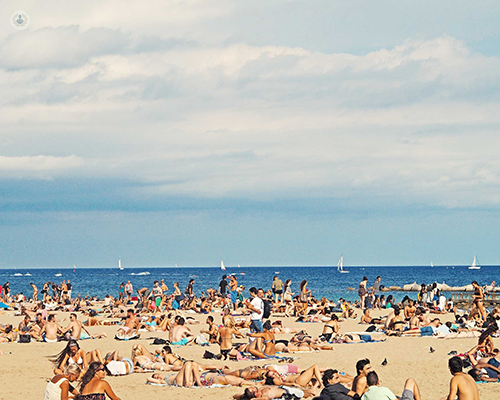How sunburns increase risk skin cancer dermatologist explains
Escrito por:We’ve all done it, and we all tell ourselves we’ll never let it happen again. In the pursuit of a golden holiday tan, we can be less than generous with the sun cream, spend too much time soaking up the sun and end up with red blistering skin and a burning desire for the aloe-vera lotion.
While we may have spoiled our long-awaited getaway, what we probably do not fully understand is what we are doing to our skin when we allow it to burn like this. Here, Dr Pick-Ngor Woo, a revered consultant dermatologist, explains what is exactly happening to our skin when we get sunburnt and how it increases our risk of skin cancer later in life.

Why does the skin turn darker in the sun?
The skin uses sunlight to help in the production of vitamin D, which is important for normal bone function and formation, however, too much can be very harmful to us.
Our skin contains the pigment melanin which protects us from the ultraviolet (UV) rays found in sunlight. When these UV rays touch our skin, they stimulate certain hormones in the lower layers of the epidermis to produce melanin that subsequently causes the skin to darken.
Producing melanin is essentially the body’s method of protecting itself from the harmful effects of UV rays. Everyone produces it, however, in darker-skinned people the body produces more, meaning that they tan deeper than lighter-skinned people and are less likely to suffer sunburns.
What is happening to the skin when you get a sunburn?
There are two main types of UV rays: UVB and UVA.
UVB is responsible for the majority of sunburns, while UVA - although causing ageing of the skin – is much less responsible for sunburns. UVC is also present in sunlight. Fortunately, however, the ozone layer prevents it from reaching the earth’s surface.
When the skin is exposed to too much UV light, it burns and turns red. UV rays penetrate through the outer skin layers and down to the deeper layers where they damage or even kill cells. This damage incites the body to increase blood flow to the area to help heal the damage.
For those with light skin, this causes the skin to turn a pink or reddish colour that is typically tender to touch. If the burn is very bad, it can peel and blister. For people with darker skin tones, a sunburn will feel itchy, tender and irritated.
How do sunburns increase the risk of skin cancer?
Research suggests that getting sunburnt just once every two years triples your risk of developing skin cancer. But how does it increase the risk?
Burning the skin from excessive exposure to UV rays damages the DNA in the skin cells of the top layer of your skin. When frequent DNA damage occurs, it can cause the cells to grow out of control and mutate; if these mutations are not corrected by the body’s repair system, then skin cancer can develop.
UV rays are also able to penetrate deeper into the dermis (lower layers of the skin) where blood vessels and nerves are found. This can damage a person’s immune system and can potentially lead to the development of skin cancers such as melanoma, which is the most serious type of skin cancer.
What factors increase your risk of skin cancer?
The more sun exposure you have had the more risk. Anyone can develop skin cancer, but certain people are at a higher risk than others:
- Paler skin types: People with a fair complexion, who have blonde or red hair, and many freckles are at an increased risk of developing skin cancer. This is because darker skin types have more melanin in their skin and therefore have more protection against the sun, whereas pale skin types are much more likely to burn.
- Childhood sun exposure: Too much sun exposure in childhood is a particular risk factor for developing cancer when you are older. Early exposures are of great concern because you essentially have a longer time to develop adverse effects from the sun.
- A family history of skin cancer: If certain family members have developed skin cancer in the past, you are at a higher risk of developing it too.
- Skin cancer in the past: People who have had any form of skin cancer in the past are at a higher risk of developing another form of the disease.
- Age: As people get older their immune system becomes less able to prevent the development of skin cancer, so they are at a higher risk.
Is there a way to reduce your risk of cancer if you’ve suffered many sunburns or had years of sun exposure?
The main thing is to avoid future sunburns, stop spending too long in the sun and always make sure you wear sun protection. It is also important to maintain a healthy lifestyle and look for any changes in the appearance of your moles.
How do you recommend people enjoy the sun?
The best way to enjoy the sun is to use a combination of shade, clothing, and sun cream.
The following is recommended:
- Spend the hottest times of the day in the shade, which is between 11 am and 3 pm. The morning and evening sun are much less intense and less likely to burn you.
- Use a sun cream with a factor of 30 or above. Apply the sun cream regularly and reapply after swimming.
- Wear suitable clothes as well as a hat and sunglasses to cover up areas of the skin that are directly exposed to the sun.
You ca't feel UV rays; the heat from the sun comes from infrared rays that do not burn you. This is why on a windy or cool day, you may not feel the sun but you can burn.
If you are worried about skin cancer and you would like to see a dermatologist, visit Dr Pick-Ngor Woo's Top Doctors profile and book a consultation.


